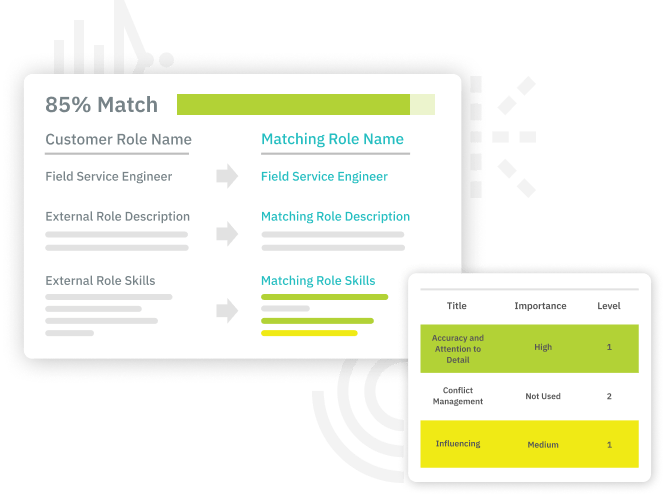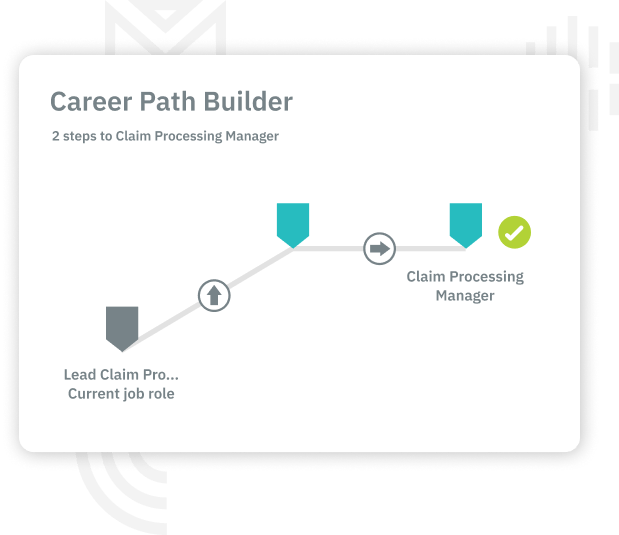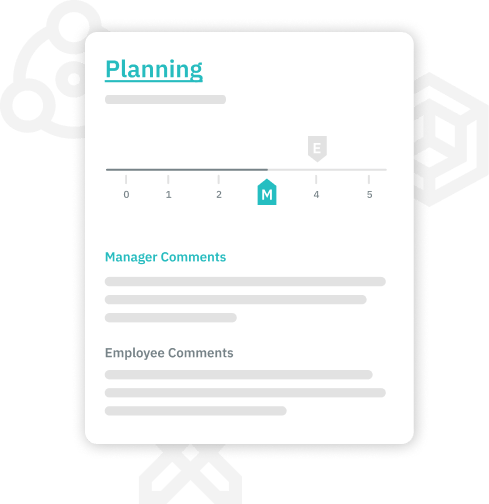Talent Strategy Framework
The ultimate platform for talent management
Our comprehensive software suite empowers you to cultivate a talent strategy framework for managing company talent at every level.

Fast & easy build-out with AI
We help you rapidly augment your job role data with skills and proficiencies (if you want them), so everyone is on the same page about the expectations of each role, the skills it requires, and how it interacts with other roles in the company.

Visibility that sparks initiative
Employees can actively explore their possibilities within the company and build career paths tailored to their competencies and goals, whether they’re aiming for the top or happy where they are.

A clear view of future needs
Enable managers to see their teams’ bench strengths, tenure risks, and gaps in role succession so they can develop their people with an eye to the future.

Real-time feedback for better learning
Performance feedback is most powerful when it happens in real time, whether it’s constructive criticism or recognition for a job well done. The performance review can be transparent between manager and employee or employee-only, or manager-only.
Get Your Free Demo & See our Platform in Action
Select from one of the bundles below and we will tailored the demo to your needs. Let us show you how TalentGuard’s solutions adapt to your industry.
Automate
Create skill profiles, create detailed job descriptions, align learning content with specific skills, and chart clear career path progressions to set the foundation for effective talent management.
Automate includes:
- Create Skill and Competency Profiles
- Develop Job Descriptions
- Map Learning to Skills and Competencies
- Map Career Path Progressions
Assess
Effectively assess their employees’ skills, identify gaps, and implement strategies to develop a skilled and competent workforce prepared to meet current and future challenges.
All the Automate features plus the ability to:
- Create a Skills Inventory
- Conduct Gap Analysis
Engage
Organizations can significantly enhance their talent development strategy and workforce effectiveness by assessing employee skills, curating personalized learning paths, recommending appropriate career paths, and tracking career goals.
All the Automate features plus the ability to:
- Assess Employee Skills and Competencies
- Curate Personalized Employee Learning Paths
- Recommend Employee Career Paths
- Track Career Goals
Optimize
Building talent pools, measuring employee performance, tracking certifications, and conducting multi-rater feedback enhance talent management, ensure compliance, and foster organizational leadership development.
All the Engage features plus the ability to:
- Build Talent Pools
- Measure Employee Performance
- Track Employee Certifications
- Conduct Multi-Rater Leadership Feedback
Trusted by:




Your workforce is changing. Never be unprepared again.
Read our eBook
Additional information
Creating (and maintaining) a robust talent management strategy is the way that strong businesses ensure they can continue to employ the best talent in their industry. Developing a talent strategy framework is the first step to getting there. An effective talent strategy framework outlines your organization’s plan to help your employees know what to expect from working with your company, and helps your company be prepared for any challenges that could come your way.
There are several different strategic elements that come together to make up a comprehensive and sound overall talent strategy. A talent strategy example of critical elements include:
- Employee engagement strategy
- Introductory onboarding and training strategy
- Ongoing learning and development strategy
- Employee recognition and reward strategy
- Promotion and advancement
- Retention strategy
- Recruitment strategy
- Hiring process and selection strategy
While many companies look to save time and find a good talent strategy template to work off of, updates in artificial intelligence and human resources software have made creating your own cohesive system much more sustainable. Just as businesses should never underestimate the importance of the role of talent management in their overall strategy, neither should they underestimate the power of creating a tailored talent strategy unique to their needs.
Talent Management Model
Broadly, there are 7 steps or “buckets” of strategy considerations involved in your overall talent strategy framework. Consider the following:
1. Talent Acquisition – in this step, businesses focus on recruiting the best talent in their industry. Strategy considerations involved in the talent acquisition bucket include which skills, background, and aptitudes are required for a particular role; how to vet candidates; and ultimately, how to make the best decision in terms of ultimate selection.
2. Performance Management – this step involves the process of continuous feedback and communication between managers and their employees to ensure the achievement of the strategic objectives of the organization. With a performance management process in place, you can lay the foundation for matching your employee tasks with your company’s greater goals.
3. Learning & Development – this aspect of your talent management model focuses on how you’ll keep the great talent you’ve recruited energized and up to speed on your industry’s nuances.
4. Career Pathing – this crucial step in the talent management process is a key aspect of both employee engagement and your overall company’s growth. Developing a clear set of career goals (including opportunities for promotion and advancement) is a great way to keep employees motivated to keep reaching for their newest personal best.
5. Succession Planning – every employee, but especially those at the top of your organization, should have a clear successor: someone who is trained and ready to meet the need of filling in for the employee’s responsibilities should they suddenly part from your firm. Identifying a candidate for succession is half of the climb, the other half involves making sure they have the training they need to fill the role effectively when and if the time comes.
6. Continuous Feedback and Improvement – providing balanced feedback through both informal and formal progress reviews help employees understand whether they’re hitting the metrics they’re measured on, and if not, how to course correct. Engaging employees in a way that both shows them what they’re doing right, as well as what points they can improve on, will help ensure that employees stay motivated and on the right rack in reaching their long term goals.
7. Analytics and Reporting – if your talent management strategy model is going to work for you, it has to provide you with data and insights. Consider the metrics you want to measure and the data you want to find: you need, at a minimum, insights on employee performance, gap identification, and quantifiable information on employee improvement and growth. Smart software can help make the process or analyzing talent information easier on managers through the analysis of many data points. The best performance management software can even connect data for you and show you insights you may not have considered before.
Talent Planning
Talent planning is an aspect of your company’s talent strategy framework that involves the concepts of both career pathing and succession planning – in other words, planning for the growth of employees while they’re at your company, and, at the same time, planning for your organization’s sustained growth after they’re gone. Instituting a proper career pathing and talent planning process also serves to combat the mounting shortage of top-notch employees in the ongoing “war for talent.”
An effective talent strategy (and planning for the succession of your employees) can help make sure that your organization never experiences a gap in the coverage of your firm’s most necessary functions. To this end, great talent management strategy examples in the planning space include aspects such as the following:
- Using HR software to help identify and close the growing number of skills gaps
- Identifying successors for necessary functions within your firm
- Boosting efficiency within your overall talent pool by locating and highlighting employee strengths and areas of growth
- Pinpointing the skills that employees in each role need to be successful
- Cross-training employees and ensuring their competencies in core skills
Talent Management Best Practices
What makes for an effective talent strategy framework? While each company has different talent strategy and planning needs depending on their unique circumstances, industry, and staffing needs, there are several talent management best practices to adhere to.
Many of the most robust and effective talent management strategies rely on modern methods of pinpointing the data points they need to make informed decisions. Advancements in human resources software relying on artificial intelligence can help companies manage all steps of the talent management process in a single platform.
With a comprehensive employee performance management software program, information collected in the performance management stage of your talent process can be used to enhance other areas of your strategy, such as career pathing or succession planning. Talent planning doesn’t have to be a guessing game; with all-inclusive HR software, you can bring a new world of ease to your talent management processes.
